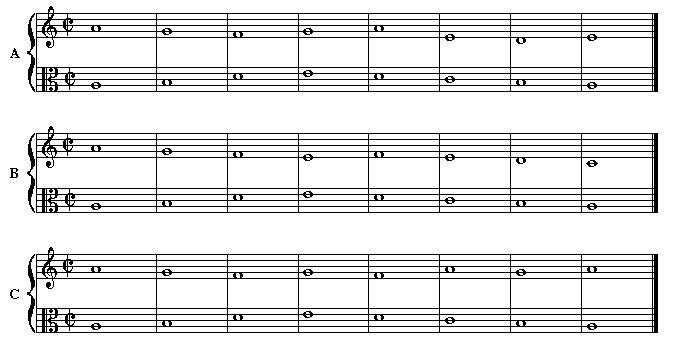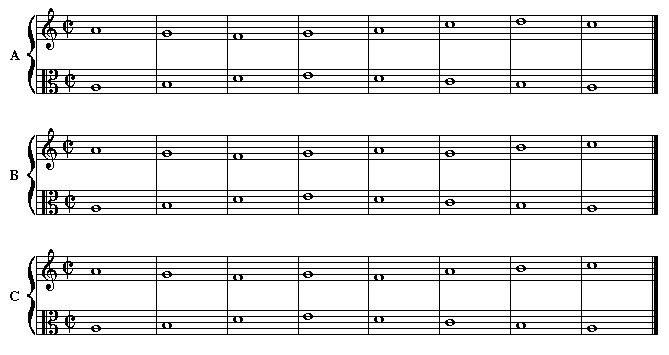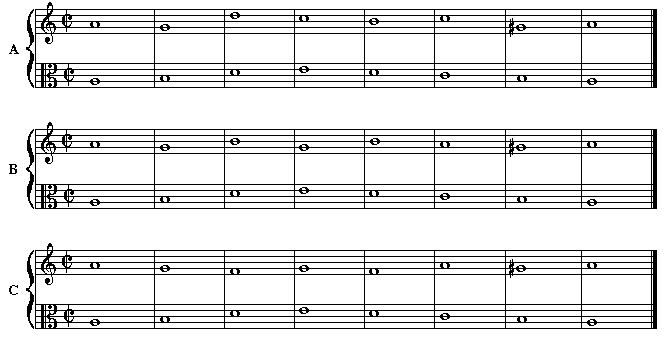SOUND PATTERNS
A Structural Examination of Tonality, Vocabulary, Texture,
Sonorities, and Time Organization in Western Art Music
by PHILLIP MAGNUSON

BASIC RULES FOR SPECIES COUNTERPOINT
Chapter 6. Species I in Two Voices
6.1 MELODIC PRINCIPLES FOR SPECIES I
-
The line must be an independent and individual line; it must have a good contour (with an unrepeated "high" or "low" point). The cantus firmi are examples of good lines.
-
Conjunct motion (steps) prevails. Disjunct motion (leaps) can be used to provide variety, but they must be handled carefully. These leaps are 3rds, 4ths, 5ths, and octaves; a 6th may be used only if it is minor (m6), and only if ascending.
-
A distance no greater than a 6th may be covered in one direction
(with the exception of the leap of an octave) with any combination of
steps and/or leaps.
This example is correct.

This example covers too great a distance.

-
Only two consecutive leaps in one direction may be used.
This example shows correct use of leaps.

This example shows that more than two leaps will travel too far a distance.

INTERLUDE 1
Click on the letter of the counterpoint that contains an error.

-
Large intervals (5ths and larger) must be counterbalanced (a change
of melodic direction), both before and after. 4ths need only be
counterbalanced on one side.
This example treats the leap of a P5 correctly, with a change of
direction both before and after the leap.

This example does NOT counterbalance the leap of a P5.

-
Do not repeat notes in adjacent measures.
Repeated mean the same pitch in two successive measures.

-
Do not leap tritones (A4ths and d5ths), and do not outline A4ths.
A tritone was traditonally known as the diabolus in musica (the "devil in music") and was actually considered evil. It was a religious imperative to avoid them in music.
This example both leaps a tritone, and outlines an A4.

INTERLUDE 2
Click on the letter of the counterpoint that contains an error..

6.2 CONTRAPUNTAL PRINCIPLES FOR SPECIES I
The unique characteristic of counterpoint is the juxtaposition of two or more independent melodic lines moving against each other. As presented in Chapter 3, there are four contrapuntal motions:
- Parallel motion: lines move in same direction, always with the same intervals
- Similar motion: lines move in same direction but not always with the same intervals
- Oblique motion: one line remains stationary while the other line moves
- Contrary motion: lines move in opposite directions
Good counterpoint is the successful mixture of these four motions.
-
All intervals must be consonant, either perfect (P1, P5, P8, or P12) or imperfect (M3, m3, M6, m6, M10, m10). P4ths are always considered to be dissonant.
-
Keep the distance between voices a 12th or less.
This example stays within the correct distance.

-
Voices may not cross (voices actually change position)
or overlap (one voice entering the territory of another in
adjacent measures).


INTERLUDE 3
Click on the letter of the counterpoint that contains an error.

-
Imperfect consonances are preferable to perfect consonances for the interior, but use no more than three 3rds or three 6ths in succession.
-
The first interval must be a perfect consonance. When writing below the cantus firmus, the first interval must be a unison or octave (a P5 below would change the
tonal center of the exercise). When writing above a cantus firmus, any perfect consonance may be used.
-
Unisons may be used in the first and last bars only. A unison is so consonant sounding that the counterpoint appears to stop momentarily when one is used.
INTERLUDE 4
Click on the letter of the counterpoint that contains an error.

-
Never use parallel perfect consonances.
Here are some examples of parallel perfect consonances:

-
Do not use direct perfect consonances (perfect intervals approached
in similar motion).
Here are two perfect consonances which are approached in the same direction.

-
Do not leap simultaneously to perfect consonances.
This must be avoided even though it is contrary motion.

Summary of the previous three contrapuntal principles (g-i):
IN SHORT, A PERFECT CONSONANCE MUST BE APPROACHED IN CONTRARY MOTION AND AT LEAST ONE VOICE MUST STEP INTO IT.
INTERLUDE 5
Click on the letter of the counterpoint that contains an error.

-
Do not leap simultaneously in the same direction more than once per exercise.
Both lines leaping at the same time takes away from the
independence of each line.

-
Provide a cadence, called a clausula vera, at the end of the exercise. A clausula vera consists of a ^7-^8 motion in one voice and a ^2-^1 motion in a second voice. Add accidentals, called musica ficta, to create leading tones at the cadence, if the mode requires one. Do not leap into musica ficta, and do not move chromatically into it.
This is an example of cadence with a tonal center of A.

INTERLUDE 6
Click on the letter of the counterpoint that contains an error.

6.3 EXAMPLE OF COUNTERPOINT IN SPECIES I

Note the inclusion of intervallic analysis. Always include this to check the accuracy of your work.
ASSIGNMENT:
SYNTHESIS
Using an assigned cantus firmus, write a soprano counterpoint
above, and a bass counterpoint below, in Species I.
This must be written as two separate pieces, one with a treble clef and alto clef, and a second with alto clef and bass clef. Follow the exact format of the example above, including the labels for the counterpoint and the cantus firmus.
Be careful to pay attention to all the principles of Species I. especially while writing a melodic line.
Cantus firmi
1. |  |
|---|
2. |  |
|---|
3. |  |
|---|
4. |  |
|---|
5. |  |
|---|
6. |  |
|---|
7. |  |
|---|
8. |  |
|---|
9. |  |
|---|
10. |  |
|---|
11. |  |
|---|
12. |  |
|---|
Links to chapters in this unit:
Link to previous unit: FUNDAMENTALS
Link to next unit: DIATONIC PROCEDURES I: Harmonic Dimensions
Copyright © 2008-2009 by Phillip Magnuson.
Content on this website is licensed under a Creative Commons License.


































